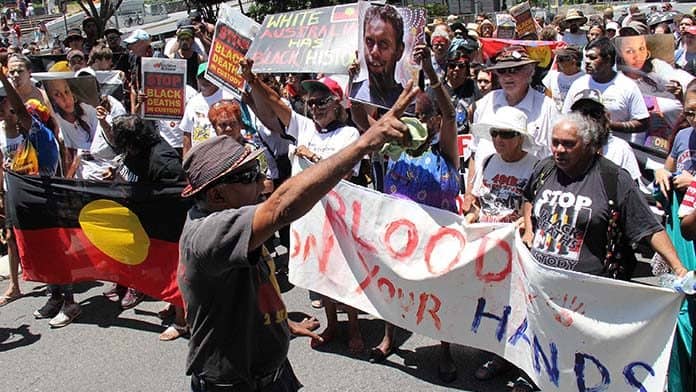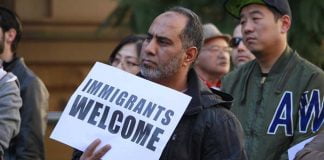On 28 September, 1983, off duty police officers in Roebourne, a remote town in WA, started racially abusing Aboriginal patrons at a hotel, sparking a brawl outside. A 16-year-old Aboriginal youth John Pat stepped into the fight. He was punched in the face by a police officer, kicked in the head by police after he fell, dragged to their waiting van and “thrown in like a dead kangaroo”, as a witness described it.
John Pat was dumped in a cell and given no medical treatment. He was found dead a little over an hour later from a brain hemorrhage.
An all-white jury acquitted the police of manslaughter charges.
Twenty-five years later, on 26 September 2008, an Aboriginal cultural leader Mr Ward was picked up by police for drink driving on a remote WA road and taken into custody in Laverton. The following morning, he was put in a rundown van by private security firm GSL to be transported 400 kilometres to the lock-up in Kalgoorlie.
The WA Inspector of Custodial Services had written reports predicting fatal consequences if prisoner transport through the scorching desert wasn’t reformed.
It was 42 degrees outside. The GSL guards knew that there were problems with the air-conditioning unit in the prisoner pod. But they didn’t check on Mr Ward, or let him out of the vehicle, for the entire trip.
Just outside Kalgoorlie, the guards heard a thump in the back of the van and drove to hospital. A nurse described the temperature in the back of the van as being “like a furnace”. Mr Ward had been literally cooked to death. Severe burns from the hot metal surfaces in the van marked his body. No one was ever charged for the death.
These horrific deaths in custody—and there have been many more—expose the brutal, systemic racism suffered by Aboriginal people in Australia.
Royal Commission
John Pat’s death fuelled a groundswell across Australia demanding action to stop Aboriginal deaths in custody and win justice for the victims.
Under pressure Prime Minister Bob Hawke announced a Royal Commission into Aboriginal Deaths in Custody in 1987.
The Royal Commission conducted a three-year investigation that cost over $50 million. It produced 339 recommendations. Almost all of them have been ignored since.
Mr Ward’s death has fuelled another groundswell over two decades later, bringing young Aboriginal activists into the WA Deaths in Custody Watch Committee. This new generation is demanding to know why the situation has become worse since the Royal Commission.
In the decade prior to the Royal Commission there were 99 Aboriginal deaths in custody. Between its final report in 1991 and 2008, there were 270 deaths. There are no publicly available figures on the number of deaths since 2008, but Gerry Georgatos, completing a PhD on the subject, has been keeping his own records: “In the last two years Aboriginal people have been dying at record levels… but there has still not been a single successful criminal prosecution against a custodial officer”.
News reports reveal many shocking incidents—including eight deaths in custody in a single month in late 2008 in the NT alone.
Two central points made by the Royal Commission are crucial for understanding this.
Firstly, Aboriginal people actually die at a similar rate to non-Indigenous people who are held in custody. The huge number of Aboriginal deaths is directly related to the disgracefully disproportionate rate at which they come into contact with the criminal justice system. And Aboriginal incarceration rates have soared since 1991.
Secondly, this incarceration can only be explained by the systemic discrimination and disadvantage faced by Aboriginal people in all aspects of their life. The Royal Commission called for “an end to domination and a return of control over their lives and communities to Aboriginal hands”. But recent history in Aboriginal politics has seen the complete opposite of this—a war on self-determination, culminating in the NT Intervention, that has pushed Aboriginal communities to breaking point.
Behind bars
The Royal Commission said that the main reason for deaths in custody was that “too many Aboriginal people are in custody, too often”. In that year, an average 2140 Aboriginal people were in prison. In the March quarter of 2012 however, an average 7873 Aboriginal people were incarcerated. That’s a 268 per cent increase in two decades.
Comparisons with the US illustrate that Aboriginal people are now one of the most incarcerated groups on the face of the planet.
The US has the world’s highest incarceration rate, with approximately 1.01 per cent of its adult population behind bars. African-Americans form by far the largest proportion of US prisoners, locked up at a rate six times higher than the white population.
In contrast, only 0.17 per cent of Australian adults are held in prison. But Aboriginal people are incarcerated at a rate 14 times higher than the non-Indigenous population. Despite being only 2.5 percent of the general population, 26 per cent of inmates are Aboriginal.
And it’s even worse in WA, where Aboriginal people are almost 20 times more likely to be locked up, and in the NT, where 83 per cent of the prison population is Black. If the NT was a country, its adult imprisonment rate of 0.85 per cent would stand in world ranking second only to the USA.
African American male adults are incarcerated at a rate of 6.6 per cent. In comparison, 4.2 per cent of Aboriginal male adults are locked up.
But in WA, the situation for Black males is actually worse than the US. An outrageous 7.2 per cent of Aboriginal men are in prison. In the NT, the figure is 5.2 per cent.
In the US, Black youth are about four times as likely to be in juvenile detention. But Aboriginal Australians are placed in detention at 28 times the rate of non-Aboriginal youth. A staggering 59 per cent of youth locked in Australia’s juvenile detention system are Aboriginal.
Structural racism
The Royal Commission argued that past policies of dispossession, child removal and racist exclusion have left lasting social scars that leave many Aboriginal people trapped in cycles of despair. A high proportion of those who died in custody, for example, have come from families affected by the Stolen Generation.
The legacy of racist attitudes that informed these policies pervade Australian society at all levels, informing police attitudes, those of employers and the general community.
It was this systemic racism that killed both John Pat and Mr Ward. The racism of the police that cracked John Pat’s head open and refused to call an ambulance. The racism of a court system that refused to convict his murders. The racism of the WA government who saw no need to upgrade their prisoner transport systems, despite explicit predictions of death from their own agency.
The Royal Commission made numerous recommendations around technical processes in the police and prison systems, some of which have been implemented—but most of which have not. The recent Briscoe case in Alice Springs shows the tragic consequences of locking up Aboriginal people simply for being drunk, a policy railed against by the Royal Commission.
A recent report published by the Indigenous Law Bulletin in February 2012 demonstrates the way that structural racism interacts with incarceration. The Investigation into hearing impairment among Indigenous Prisoners within the NT Correctional Services found that 94 per cent suffered from “significant hearing loss”, with 76 per cent of inmates struggling to hear corrections staff.
It is government neglect and the third world conditions in most NT communities that are to blame for tragic rates of ear infection and subsequent hearing loss. The study suggests that once impaired, people are more likely to drink and fight to escape frustration, less likely to have a job and ultimately more likely to come into contact with the police. They are then unable to negotiate with police or advocate for themselves in the system.
Another study published by the Medical Journal of Australia in June 2012 found that 90 per cent of Indigenous women in Queensland prisons have a mental illness. They were also far less likely than non-Indigenous inmates to have accessed any treatment or support service before being locked up.
Paternalism
The Royal Commission’s central goal was the “empowerment of Aboriginal society on the basis of their deeply held desire, their demonstrated capacity, their democratic right to exercise… maximum control over their own lives and that of their communities”.
In contrast, the Howard government slashed the Aboriginal Affairs budget, gutted an already weak Native Title system, forced Aboriginal communities into demeaning “Shared Responsibility Agreements” and disbanded the Aboriginal and Torres Strait Islander Commission (ATSIC).
Howard also began the closure of Community Development Employment Projects (CDEP), closures that Labor has now implemented. Up to 35,000 jobs have been wiped out in Aboriginal communities, crippling Aboriginal organisations.
The NT Intervention was their nail in the coffin for any notion of self-determination.
Aboriginal men have been demonised as drunken child abusers and control over all aspects of Aboriginal life has been taken away.
Disgracefully, Labor has continued this Intervention and just passed “Stronger Futures” legislation that will extend its key powers until 2022 (see page 8).
The recent growth in the numbers of Aboriginal people locked up—and dying in custody—indicates the growing level of oppression of Aboriginal people thanks to the policies of the Howard government and their extension by Labor.
Family spokesperson Patricia Morton-Thomas has said her nephew Kwementyaye Briscoe was, “a victim of the NT Intervention”. This is not just because there are more police, with more powers, than before 2007, but also because, “the Intervention has let every closet racist in the Territory to come out”. It has dehumanised Aboriginal people, legitimising the sort of brutal treatment and indifference to suffering demonstrated by the police in the Briscoe case.
Without turning around policies like the NT Intervention, there will be more Aboriginal people behind bars and more grieving families.
By Paddy Gibson






